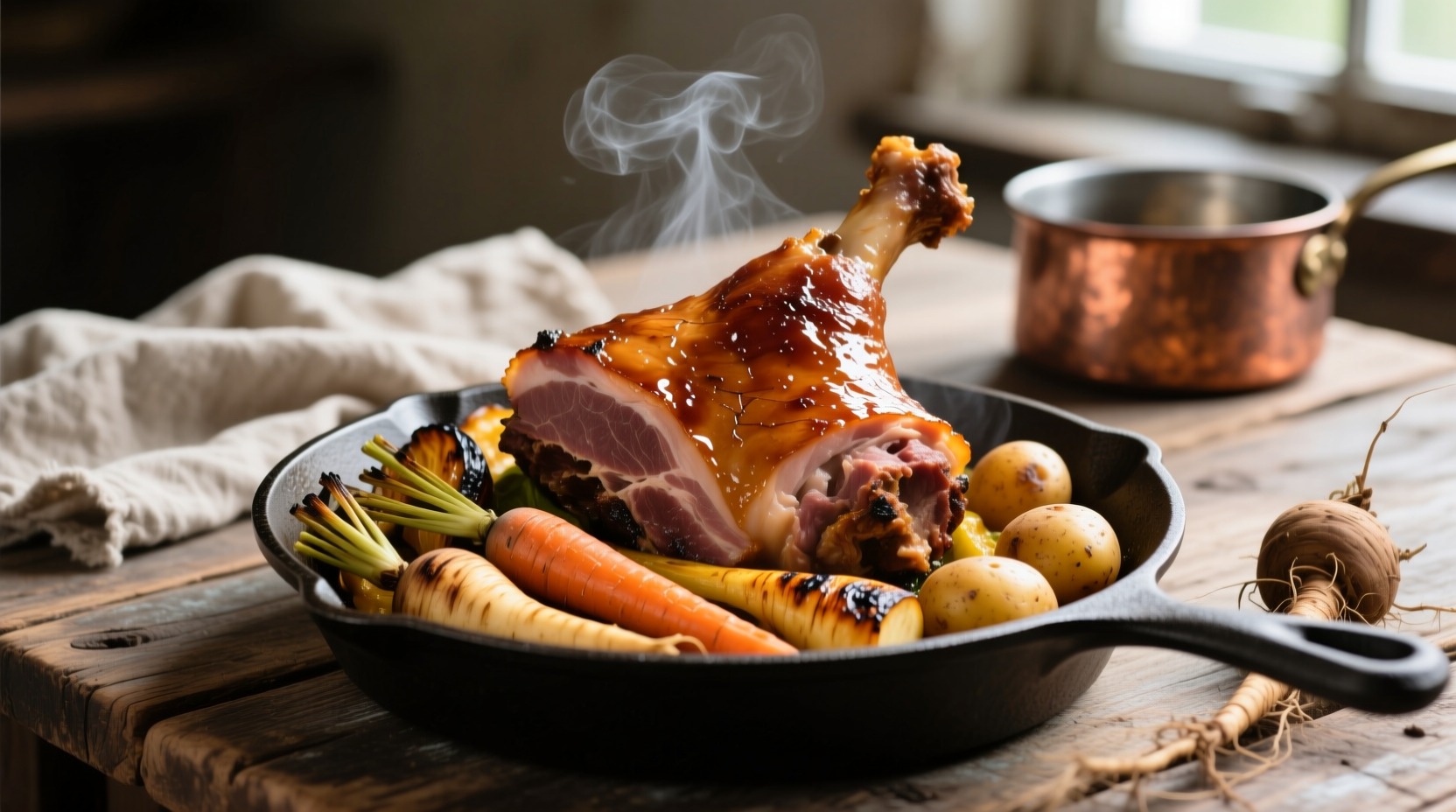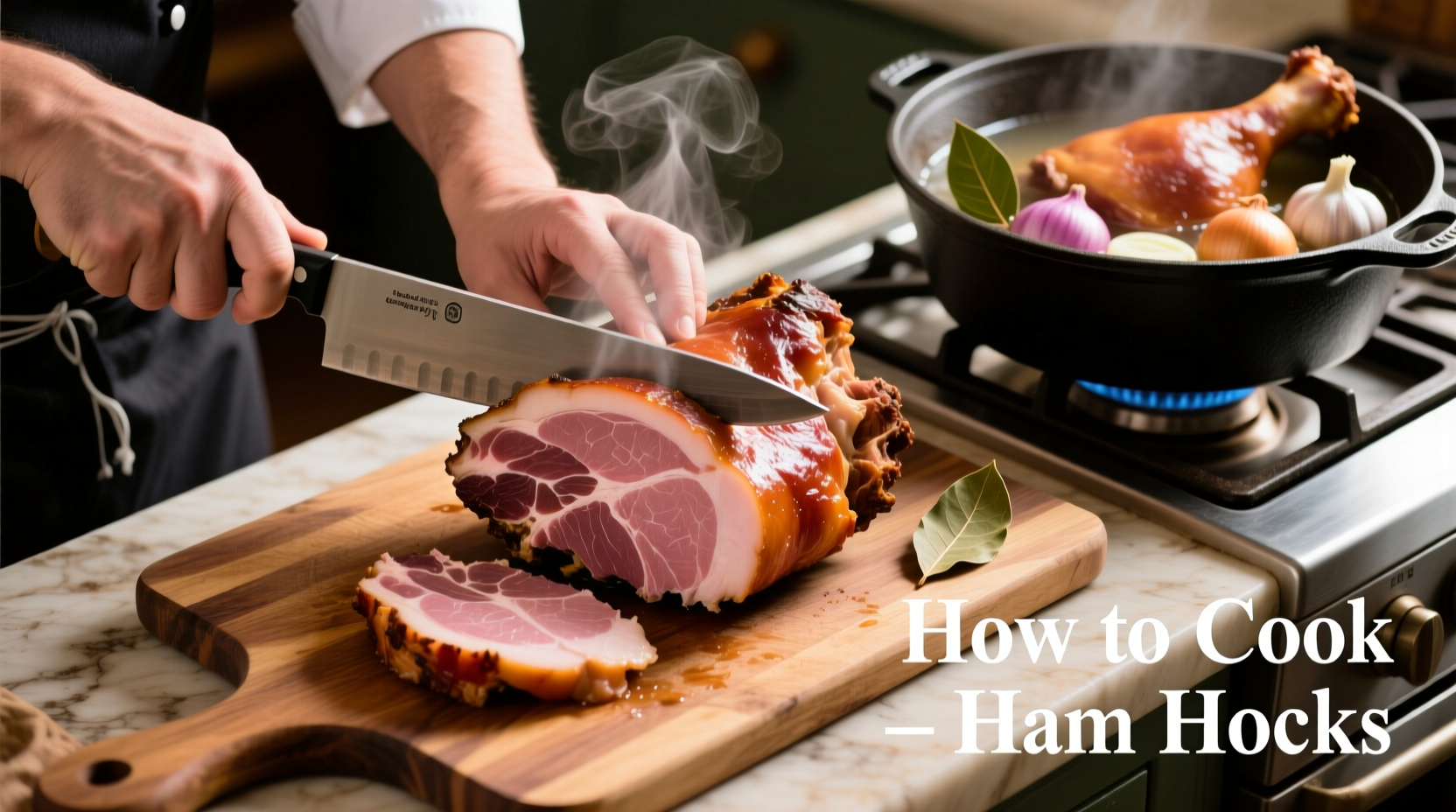Perfectly cooked ham hocks require 2-3 hours of simmering at 180-205°F (82-96°C) until fork-tender. Start by soaking overnight to reduce saltiness, then simmer with aromatics for rich flavor. USDA recommends cooking pork to 145°F (63°C) internal temperature for safety.
Transform humble ham hocks into succulent, flavorful dishes with these professional techniques. Whether you're preparing traditional Southern peas, hearty bean soups, or modern braised creations, understanding the proper preparation and cooking methods makes all the difference. This guide delivers tested methods that guarantee tender results every time, avoiding the common pitfalls of tough meat or overwhelming saltiness.
What Are Ham Hocks and Why They're Worth Cooking
Ham hocks (also called pork knuckles) are the lower portion of a pig's hind leg, connecting the ham to the foot. This tough, collagen-rich cut transforms into meltingly tender meat when cooked properly, infusing dishes with deep pork flavor. Unlike bacon or ham, hocks contain more connective tissue and less meat, making them ideal for slow cooking where collagen breaks down into gelatin.

Essential Preparation Steps Before Cooking
Proper preparation prevents overly salty results and ensures even cooking:
- Soak overnight - Submerge in cold water for 8-12 hours, changing water 2-3 times to reduce salt content
- Clean thoroughly - Scrub exterior with a brush to remove any surface impurities
- Blanch first - Simmer for 10 minutes, then discard water to remove impurities
- Trim excess fat - Remove thick fat layers if preferred, though some enhances flavor
| Preparation Method | Time Required | Effect on Final Dish |
|---|---|---|
| No soaking | None | Very salty flavor, may require reduced added salt |
| 4-hour soak | 4 hours | Moderate salt reduction, good for quick recipes |
| Overnight soak | 8-12 hours | Ideal salt level for most recipes, recommended method |
Four Reliable Cooking Methods Compared
Classic Simmering Method (Most Traditional)
This time-honored approach yields the most flavorful broth and tender meat:
- Place soaked, blanched ham hocks in large pot
- Cover with 2 inches of cold water or broth
- Add aromatics: 1 onion (quartered), 2 celery stalks, 2 carrots, 3 garlic cloves, bay leaves
- Bring to gentle simmer (do not boil rapidly)
- Cover and cook 2-3 hours until fork-tender
- Check water level periodically, adding more if needed
According to the USDA Food Safety and Inspection Service, pork products like ham hocks should reach a minimum internal temperature of 145°F (63°C) with a three-minute rest time for safety. The extended cooking time for ham hocks far exceeds this requirement, ensuring both safety and tenderness.
Slow Cooker Method (Most Convenient)
Ideal for hands-off cooking with consistent results:
- Place prepared ham hocks in slow cooker
- Add 1 cup liquid (water, broth, or apple cider)
- Cook on LOW for 6-8 hours or HIGH for 3-4 hours
- Check for tenderness after minimum time
Oven Braising Method (Best for Crispy Skin)
For those wanting slightly caramelized exterior:
- Preheat oven to 325°F (163°C)
- Place hocks in Dutch oven with 1 inch liquid
- Cover tightly and braise 2.5-3 hours
- Uncover last 30 minutes for skin crisping
Pressure Cooker Method (Fastest Option)
Significantly reduces cooking time while maintaining tenderness:
- Add 1 cup liquid to pressure cooker
- Place hocks on trivet above liquid
- High pressure for 45-55 minutes
- Natural release for 15 minutes before opening
Flavor Enhancements That Make a Difference
Elevate your ham hocks with these professional flavor combinations:
- Acid balance - Add 2 tablespoons vinegar or lemon juice during last 30 minutes
- Sweet contrast - Include 1-2 tablespoons brown sugar or maple syrup
- Herb bundles - Tie thyme, rosemary, and parsley with kitchen twine
- Vegetable additions - Add during last hour: potatoes, turnips, or cabbage
Culinary research from the Institute of Food Technologists shows that the Maillard reaction (browning) at temperatures above 285°F (140°C) creates complex flavor compounds that significantly enhance the umami profile of cooked meats. This explains why the oven braising method often produces the most flavorful results despite longer cooking times.
Testing for Perfect Doneness
Don't rely solely on cooking time—check for these doneness indicators:
- Fork test - Meat should pull away easily from the bone
- Texture - Collagen should have transformed to gelatin (tender, not rubbery)
- Internal temperature - Should register 195-205°F (90-96°C) for optimal tenderness
- Shrinkage - Meat will visibly pull back from the bone
Serving Suggestions and Traditional Pairings
Ham hocks shine in these classic preparations:
- With beans - Add to pinto, navy, or black-eyed peas during last hour of cooking
- In soups - Remove meat from bone, shred, and return to broth with vegetables
- As standalone dish - Serve with mashed potatoes and collard greens
- For flavor base - Use resulting broth as foundation for stews and sauces
Troubleshooting Common Ham Hock Issues
| Problem | Causes | Solutions |
|---|---|---|
| Tough meat | Insufficient cooking time, too high heat | Return to gentle simmer for additional 30-60 minutes |
| Overly salty | Inadequate soaking, salted during cooking | Add raw potato slices to absorb excess salt, or dilute with unsalted broth |
| Bland flavor | Lack of aromatics, insufficient cooking time | Add additional seasonings and simmer 15-20 minutes more |
Storing and Reusing Leftovers
Maximize your cooking effort with these storage tips:
- Refrigeration - Store in broth for up to 4 days
- Freezing - Freeze with broth in airtight containers for up to 3 months
- Meat removal - Shred meat from bone for quick additions to soups and beans
- Broth utilization - Strain and freeze cooking liquid for future recipes











 浙公网安备
33010002000092号
浙公网安备
33010002000092号 浙B2-20120091-4
浙B2-20120091-4